There is no doubt that the southern part of India boasts of some of the most beautiful and majestic temples in India. The temples of South India are usually unique in their architecture and intricate designs. The ancient temples of India are best examples of exquisite craftsmanship and they also depict the rich cultural heritage of the country. Some of these temples are revered sites of pilgrimage as well. Keeping aside religion and pilgrimage, some of these temples need to be visited because of their sheer magnificence, architecture and the grandeur.
Sometimes I believe the temples of South India exudes more grandeur than temples in other parts of India. Just look at the Great Living Chola Temples or the temple complex of Aihole, Badami and Pattadakkal or the Shore Temples of Mahabalipuram; each of them is a masterpiece in their own right. The temples of South India mostly follow the Dravidian style of architecture marked by tall towers or gopurams, stone structures, sculptures depicted in stones and intricate inscriptions. The style and design differ as these temples are built by the several ruling dynasties dedicated to their family deity. Each dynasty and period has some special characteristic. However, I would not go into such details and simply would enumerate here a few temples of South India as suggested by some of my fellow bloggers and writers. Believe me, these are some of the best ones in India.
Famous Temples of South India
Tamil Nadu Temples
-
Brihadeeswarar Temple, Thanjavur

Brihadeeswarar Temple is one of the most architecturally delightful temples of South India. Built by the Raja Chola Chola I in 1010 AD, the temple was built to show the might and power of the reigning Chola dynasty. Also known as the Big Temple of Thanjavur, it is now a UNESCO World Heritage Site and is one of the most important temples of South India.
There are nearly 15 structures and shrines inside the Brihadeeswara Temple complex in Thanjavur, but not all of them were built by Raja Raja Chola. The main temple was built by him and the rest structures were gradually added later by different kings and dynasties. Thus the architecture of the shrines inside the Brihaddeswarar temple complex has the influence of various dynasties. The temple is dedicated to Lord Shiva. The idol of Nandi in front of the main shrine is said to be the second-largest in India.
Brihadeeswarar Temple is located in Thanjavur. The nearest airport and railway station is at Trichy. There are buses available from Trichy to Thanjavur.
Contributed by Agni and Amrita from Tale of 2 Backpackers
-
Ramanathswamy Temple, Rameswaram

Ramnathswamy Temple is prominently dedicated to Lord Shiva and located at Rameswaram in the state of Tamil Nadu. It is one of the twelve Jyortiling Shrines of Lord Shiva. The primary deity, the Lingam of Lord Shiva (Ramanathswamy) is believed to be established and worshipped by Lord Rama himself.
There are two lingams inside the sanctum – one built by Rama, from sand, residing as the main deity, Ramalingam and the one brought by Hanuman from Kailash called Vishwalingam. Rama instructed that the Vishwalingam should be worshipped first since it was brought by Hanuman and said Lingum is at the entrance of the temple and this tradition continuing today also.
Like all temples of South India, it has a high compound wall all four sides with huge Gopurams (towers). The temple has strikingly Long corridors in its interiors. The outer corridors said to be longest in the world with 1212 Pillars with a height of 30 feet. The present architecture involves so many changes over the centuries. The pillars are beautifully painted and give a treat to the eyes with rich colours. There are 22 Tirthas (water body) in the temple complex and it has religious importance. One needs to follow bathing rituals before offering prayers to Lord Shiva. One must visit this temple not only for religious importance but to marvel its architecture.
Temple visit timings are morning 5 AM to 1 PM and afternoon 3 PM to 9 PM
Entry from west Gate is recommended to avoid the crowds.
Contributed by Mayuri Patel from Ferwehrahee
-
Mahabalipuram Temples

The UNESCO site of Mahabalipuram contains several sites that spread along the island with a few temples that have their own distinct architectural style. Most of the structures are said to have been built under Narasimhavarman I, as a memorial to the Pallava victory over King Chalukya Pulakesin II. The first, Tiger Temple, is located around 10 minutes from the other major landmarks and is therefore quite serene. It’s a small temple with ornate carvings of tigers but looks more like mythical creatures.
The main temple at Mahabalipuram is Shore Temple which is close to the beach at the Bay of Bengal. After purchasing the $10 admission ticket, witness the 8th century AD structure that’s made of two granite dugout structures. The temple has survived a tsunami and erosion but it does show. The complex is open from 6 AM to 6 PM daily.
There is another small temple above the Mahishamardini Rock Cut Mandapa called Olakkannesvara Temple, dating back to the 7th century Pallava Dynasty. As it is perched high up on a boulder, it was strategically used as a lighthouse to alert ships. It also has some epic views of the area and the ocean. The name is said to come from “Ulaikkannisvaram” referring to the crescent moon shape on Shiva’s forehead.
There are other sites which aren’t temples per se, but are also beautiful to witness. Pancha Rathas contains five structures dedicated to the Pandavas, which is a Hindu epic. Arjuna’s Penance is a 30m wide rock carving on the side of two pink granite boulders from the 7th century that shows the creation of the Ganges following Bhagiratha.
While you can stay at one of the luxury hotels nearby, getting to the Mahabalipuram complex from Chennai is relatively easy by bus, car or taxi at around 56km. Men are expected to wear a dhoti, or trousers (no jeans and t-shirt), and women should have their arms and legs fully covered. Don’t miss the Mahabalipuram Dance Festival held every year during Dec-Jan.
Contributed by Cal from Once in a Lifetime Journey
-
Kanchipuram Temples

One of the most epic road trips that we went on was from Bangalore to Pondicherry. On the way, we stopped by a town called Kanchipuram, which is renowned for its sarees. Yes! That was all that I knew about the town before I visited it. Imagine my surprise when we realized that Kanchipuram is also home to some of finest temples of South India.
The Kanchipuram temples are actually a pilgrimage spot for many Indian devotees. While the town made a great stop on our road trip, we were able to explore only a couple of the temples because we ran short of time. One of the temples that really caught my attention was the Kanchi Kailasanathar Temple. While it looked small, it was far from insignificant. Every single wall of the temple was covered with intricate carvings. Dedicated to the Hindu God Shiva, this temple has a Shiv ling or a cylindrical statue in the inner sanctum.
The pandit explained that while we were not allowed to click photographs, we were more than welcome to visit the inner parts of the temple. Even though the temple is small, you can spend a lot of time admiring the art on the walls. I highly recommend visiting it.
Contributed by Penny from Glove Trove
-
Arunachalesvara Temple

Arunachalesvara Temple, which is also sometimes referred to as Annamalaiyar Temple, is located in Tiruvannamalai. The original temple was built in the 9th century by the Chola kings, although there have been many additions and renovations since then. Arunachalesvara’s most distinctive architectural features are its four gopurams, or gateway towers, at each of the four compass points. The biggest one is the eastern gopuram, which was built in the 15th century by King Krishnadevaraya and stands 66 meters tall.
If you can time your visit to coincide with the full moon, you’ll get to experience the amazing night-time pilgrimage here, when up to 500,000 Shiva devotees circumambulate around the hill behind the temple. This is the biggest temple in the world that’s dedicated to Shiva, who is worshipped here in the form of fire.
On the night of the full moon during the month of Karthik, which falls in either November or December, the spectacular Karthikai Deepam festival is celebrated. A fire representing Shiva is lit on top of the hill, where according to legend he appeared as a column of fire to return light to the Earth after his wife Parvati had closed his eyes and accidentally plunged the world into darkness.
People of all faiths and nationalities are welcome to visit the temple; just remember to dress conservatively, wearing clothes that cover your shoulders and knees. In summer, try to avoid visiting in the midday heat, as the paving slabs become so hot that they can burn your feet (you’ll have to remove both your shoes and your socks to visit the temple).
Tiruvannamalai is well connected by rail and road to other cities in southern India and can easily be combined with a visit to Bangalore and/or Pondicherry.
Contributed by Wendy Werneth from The Nomadic Vegan
-
Suchindram Temple

Courtest: Wikimedia
Suchindram Temple, located between Kanyakumari and Nagercoil is one such temple where the Holy Trinity of Hindu Gods – Brahma, Vishnu and Maheshwar are worshipped together. The shrine is dedicated to ‘Sthanumalaya’, the trinity of God. The linga here is in three parts. The top represents “Sthanu” name of Siva, the middle “Mal” name of Vishnu, and the base “Aya” name of Brahma. The temple is also related to the legend of chastity of Anusuya, wife of sage Atri.
The Suchindram temple is one such temple of South India that is revered by both the Vaishnavites and the Shaivites. The temple built in the 17th century is known for its rich architecture. The royal gopuram is spread into seven steps. The first 2 storeys depict the tales from Mahabharata and Ramayana while the remaining 5 depicts stories about the temple. The carvings and paintings form valuable historical records to learn about the period.
The temple remains open from 4.30 AM to 11.30 AM and from 5.00 PM to 8.30 PM.
Suchindram Temple is about 11 km from Kanyakumari and 7 km from Nagercoil. You will get buses from both the towns to the temple.
Contributed by Agni & Amrita from Tale of 2 Backpackers
-
Chidambaram Nataraj Temple, Chidambaram, Tamil Nadu
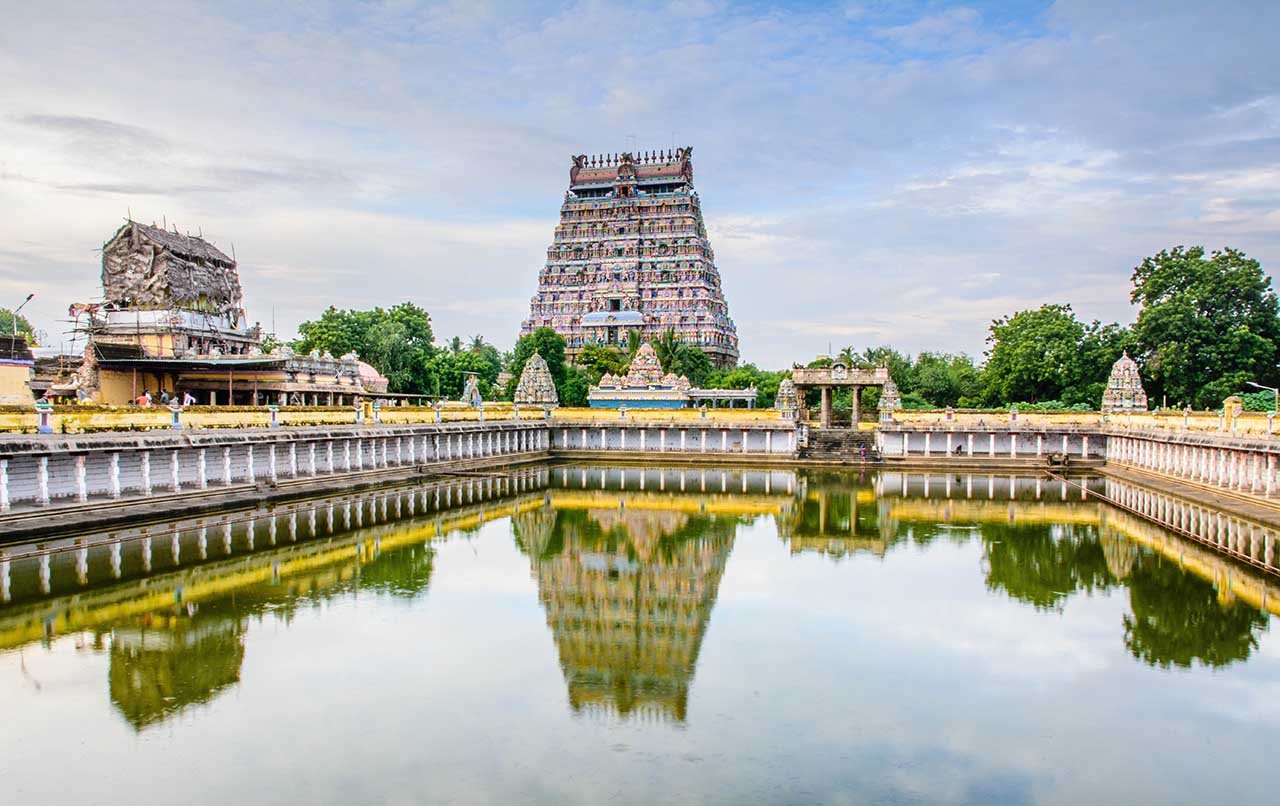
Located in the town of Chidambaram, the Chidambaram Nataraj Temple is one of the ancient and revered temples of Tamil Nadu. Also known as Thillai Nataraja Temple, Chidambaram Temple is one of the Pancha Bhoota Sthalam (representing the five natural elements) of Lord Shiva that represents Akash (aether). The other four temples are the Thiruvanaikaval Jambukeswara in Trichy representing water, Kanchi Ekambareswara in Kanchipuram representing earth, Thiruvannamalai Arunachaleswara in Thiruvanamalai representing fire and Kalahasteeswara in Kalahasti representing wind.
This ancient temple of the Cholas is unique as it is one of the rare temples where Lord Shiva is represented as an idol and not the customary Shiva lingam. Here the idol is in the form of Nataraja or the dancing Shiva. The Cosmic Dance of Lord Nataraja symbolises the motion of the universe as sustained by Lord Shiva. The word Chidambaram comes from 2 words “Chit” meaning consciousness and “ambaram” meaning sky. The name signifies the ’sky of consciousness’, that one should always try to attain.
The temple complex is spread over an area of 50 acres right in the middle of the town. The temple is dedicated to both Lord Shiva as well as Lord Govindaraja Perumal (Lord Vishnu) and is one of the few temples where both Shaivite and Vaishnavite deities are present in the same place.
The temple has been renovated by several dynasties, the most important ones were the Pallavas, Cholas, Pandyas, Cheras and the Vijaynagar kings during the period of ancient and medieval history.
You can enter the temple for darshan between 6 AM to 12 noon and again from 5PM to 10 PM.
The nearest airport is at Trichy (195 km) and Chennai (235 km). Chidambaram is well connected with bus routes from these places.
Contributed by Agni & Amrita from Tale of 2 Backpackers
-
Meenakshi Ammam Temple, Madurai

Meenakshi Ammam Temple located in Madurai is one of the oldest and revered temples of South India. It is believed that Kulashekarar Pandyan of Pandya dynasty had built this temple during the 1st century AD after receiving a divine intervention from Lord Shiva. The temple structure as it stands today was rebuilt several times by several kings and dynasties. The Nayak rulers were significant contributors to the number of structures of the temple.
The Meenakshi Temple is located in the heart of Madurai city and occupies an area of 14 acres. The temple is enclosed within huge walls and when viewed from above represents a Mandala. The temple is dedicated to Goddess Meenakshi and Lord Sundareshwar, the handsome form of Lord Shiva. It is believed that Lord Shiva assumed the form of Sundareshwar (the handsome one) to marry Meenakshi (Goddess Parvati) at the site where the temple is currently located.
Meenakshi Temple has 4 towering Gopurams that look quite similar to each other. Apart from the 4 main Gopurams, there are 10 other gopurams serving as gateways to other smaller shrines inside the temple complex. The temple also has a number of pillared halls known as Mandapams. The Ayirakkal Mandapam is the most significant one having as many as 985 pillars.
Madurai can be reached by trains running from Chennai. It also has a domestic airport.
Contributed by Agni & Amrita from Tale of 2 Backpackers
Andhra Pradesh Temples
-
Veerabhadra Temple of Lepakshi

Located in Andhra Pradesh, the Veerabhadra Temple of Lepakshi is a man-made wonder of medieval India. Well, that is if you ignore the folklore that it was built by an ancient sage Agastya with magical powers. The more commonly accepted history is that the temple was built during the reign of King Achyutaraya, the monarch of the great Vijayanagara Kingdom.
The temple is built in the honour of Veerabhadra, the fierce form of God Shiva when he was painfully enraged at the death of his consort Sati. But the temple also depicts important events of Ramayana, as if they happened right here. The temple for obvious reasons is abounding with mystery and legends.
Of the numerous beautifully sculpted pillars of the temple, one of them does not touch the ground! A thin paper can pass between the floor and the pillar seamlessly. Legends say that once a British engineer tried to move one this pillar out of curiosity, but as soon as he tried to do so, all the pillars started shaking and he fled out of fear. The frescoes inside the temple surprisingly retain their colour. Outside the main temple is a verandah bound by another set of pillars. Several notable structures are found here including the Nagalinga, the giant footprint, the Ganesha Mandapa and the Ardha Mandapam (an unfinished ceremonial altar). Each of these has one or more intriguing legends associated with it. The sculptures and the legends make this an unforgettable experience.
Contributed by Sinjana from Backpack & Explore
-
Tirupati Temple
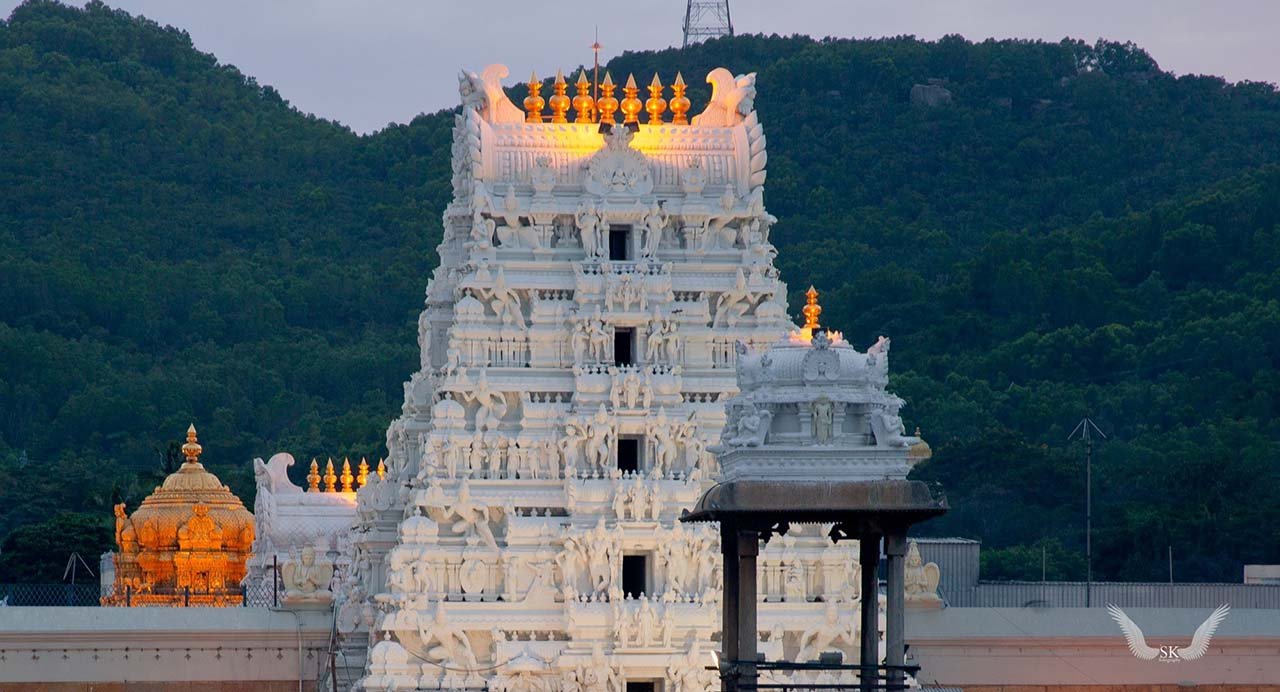
Tirupati Tirumala Venkateshwara Swamy Temple or the Tirupati Temple is one of the most revered temples in India. Not only that, it is believed to be one of the richest temples in the country as well. The temple is located on the Tirumala hills in Andhra Pradesh. The temple is dedicated to Lord Venkateshwara and is visited by almost 50000 pilgrims every day. The architecture of the temple is a typical Dravidian style with a colourful Gopuram.
It is a custom among the devotees to shave their head in the temple and dedicate the hair to the Lord to get their wishes fulfilled.
The nearest railway station is Tirupati, 26 km from Tirumala. Buses are available from Chennai, Bangalore, Vellore and Tirupati to Tirumala where the temple is located.
Karnataka Temples
-
Chennakeshava Temple

Tucked away somewhere in the sleepy little town Belur in South India, The Chennakeshava Temple stands out thanks to its exquisite architecture and a certain timelessness. Built by King Vishnuvardhana in 1117 CE, it still attracts both pilgrims and tourists from around the world.
It took an astounding 103 years to build this temple. Despite being damaged and plundered several times in the past, the temple still stands tall and is in good shape.
There are several big and small temples in the walled compound that surrounds the Chennakeshava Temple. The temple was built with soft soapstone, as it allowed the artists to carve the stone easily. This Hoysala temple has many carvings of Hindu deities on the exterior walls of the temple. Not only can you see the carvings of Hindu epics Ramayan and Mahabharat here but also some erotic sculptures on few walls.
You will easily get a learned local guide who will show you the hidden characters of the temple and will guide you through the amazing architectural gems of the 12th-century temple.
Early mornings are the best time to visit the temple due to the easy availability of public transport. It is a remote place and finding hotels and public transport in the evening is very difficult and at times impossible.
Chennakeshava Temple is located just 35 kilometres and 200 kilometres away from Hassan and Bengaluru respectively. Both Hassan and Bengaluru have a railway station and are connected with all major cities of India via railway and bus. Bengaluru also has an international airport.
A trip to Belur can be planned along with nearby gems such as Shravanbelagola and the Hoysaleswara temple in Helbidu.
Contributed by Abhinav Singh from A Soul Window
-
Virupaksha Temple, Hampi

Hampi is famous for its ancient temples from the Vijayanagara Empire. In the 14th century, Hampi was its capital and lots of impressive archaeological sites remain. The Virupaksha temple stands out. Not only because it is older than most temples in Hampi, but also because it is the only active temple for Hindus.
The temple is dedicated to Lord Shiva and is considered to be one of the most sacred temples in Hampi. Hindu pilgrims still come to worship here everyday since the 7th century. This was long before the Vijayanagara Empire dominated the area.
The Virupaksha temple was a small shrine back then and it is not known who exactly built the first structure. However, throughout the years, different people contributed towards its development into a large complex. Among them were some of the Vijayanagara kings as well.
When Hampi was destroyed by Muslim armies in 1565 the temple was also damaged, but even then worship continued. Nowadays the temple still attracts pilgrims. In February there is the annual chariot festival and in December a festival that celebrates the marriage of Virupaksha and Pampa.
When visiting the temple, dress modestly and beware of the cheeky monkeys and Laxmi, the temple elephant.
Hampi is in the north of Karnataka and easy to reach by train. There is a daily night train from Bangalore to Hospet. From Hospet you can take an auto to Hampi.
Contributed by Ellis from Backpack Adventures
-
Cave Temples of Badami

The Cave Temples of Badami in the south Indian state of Karnataka are one of the most unique temples in India. Carved seamlessly into huge sandstone cliffs that overlook a massive lake, these rock-cut temples present an extremely picturesque sight.
Badami’s cave temples include 4 main temples, three of which are dedicated to Hindu gods. The last one which is also on the highest hill is a Jain temple featuring Jain Tirthankaras. In the first cave, you will find a fascinating image of Nataraja (Shiva’s dancing form). As you climb up to the second temple, notice the relief under the verandah that showcases mythical dwarfs in various poses. They are believed to depict life from the Chalukyan era. The third cave is the largest and probably the most famous. On display here is a captivating image of Lord Vishnu seated on a serpent. There are also some interesting frescoes on the ceiling.
You will have to climb a few stairs to get to each temple. Wear comfortable shoes. Also, beware of monkeys who are always looking out for food. As you make your way up to the temples, make sure you take a good view of the Agastya Lake and the almond-coloured hills behind it. This is an image that will stay with you for life.
Contributed by Soumya from Stories by Soumya
-
ISKCON Temple in Bangalore
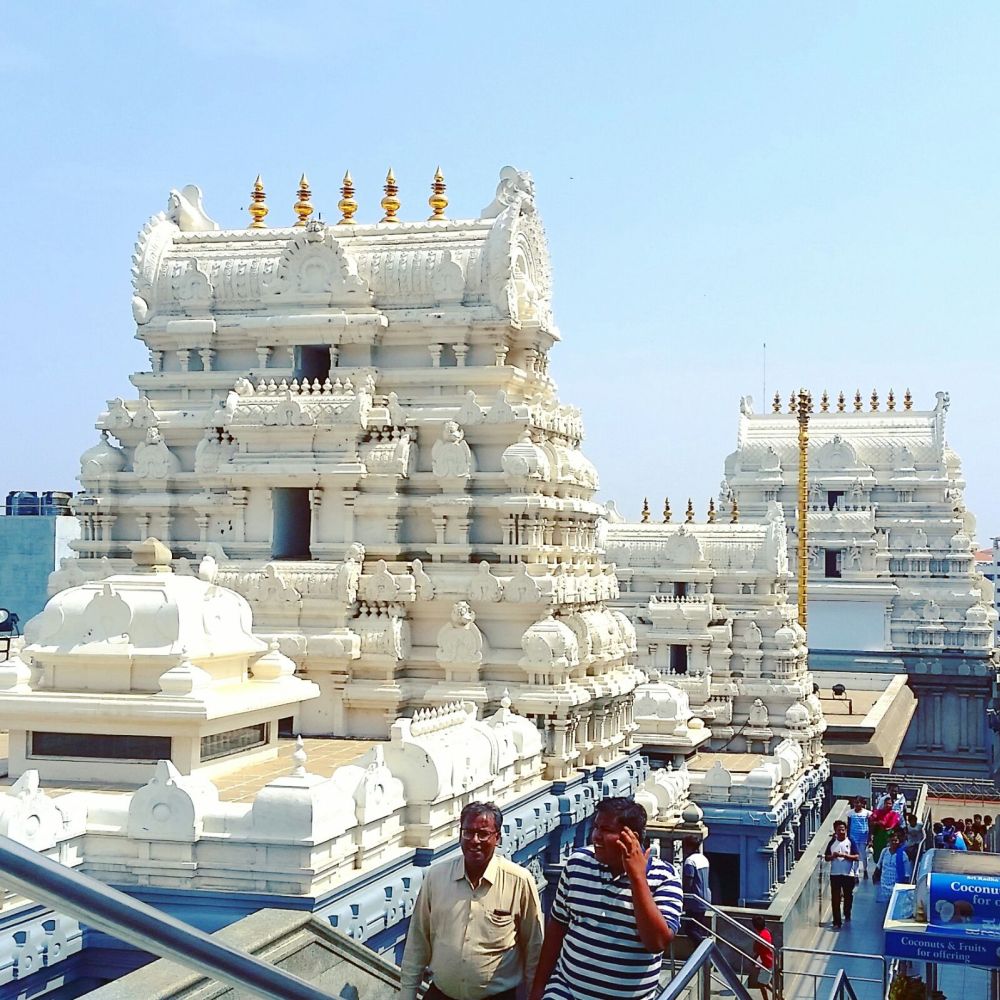
The ISKCON temple in Bangalore, also known as Sri Radha Krishna Temple, is one of the largest ISKCON temples in the world. It’s a huge cultural complex in the north of the city that was inaugurated in 1997 by Dr. Shankar Dayal Sharma and although it’s often remarked that it looks like a giant wedding cake, it has the substance to match the style.
During our year living in India, it was one our favourite things to do in Bangalore with kids. Leaving our shoes with security at the entrance, along with cameras (there’s a strict no photography rule here), we would climb the steps to marvel at the lavish decorations and stop to observe the fascinating ceremonies taking place. At all times in your visit, the Hare Krishna chant provides a looping soundtrack.
Make sure you’re shoulders and legs are covered and don’t worry about burning your bare feet on the white marble as there are carpets laid out.
Towards the end of your visit, following the signed pathways, you will come across a fantastic food market. Everything here is vegan and absolutely delicious. So I recommend timing your visit with lunch.
As with everywhere in Bangalore, get there early in the day to avoid the crowds and allow time to get through the notorious traffic. The easiest way to get there is to order an auto or car on Ola or Uber.
Contributed by Jenny from TraveLynn Family
-
Murudeshwar Temple, Murudeshwar, Karnataka
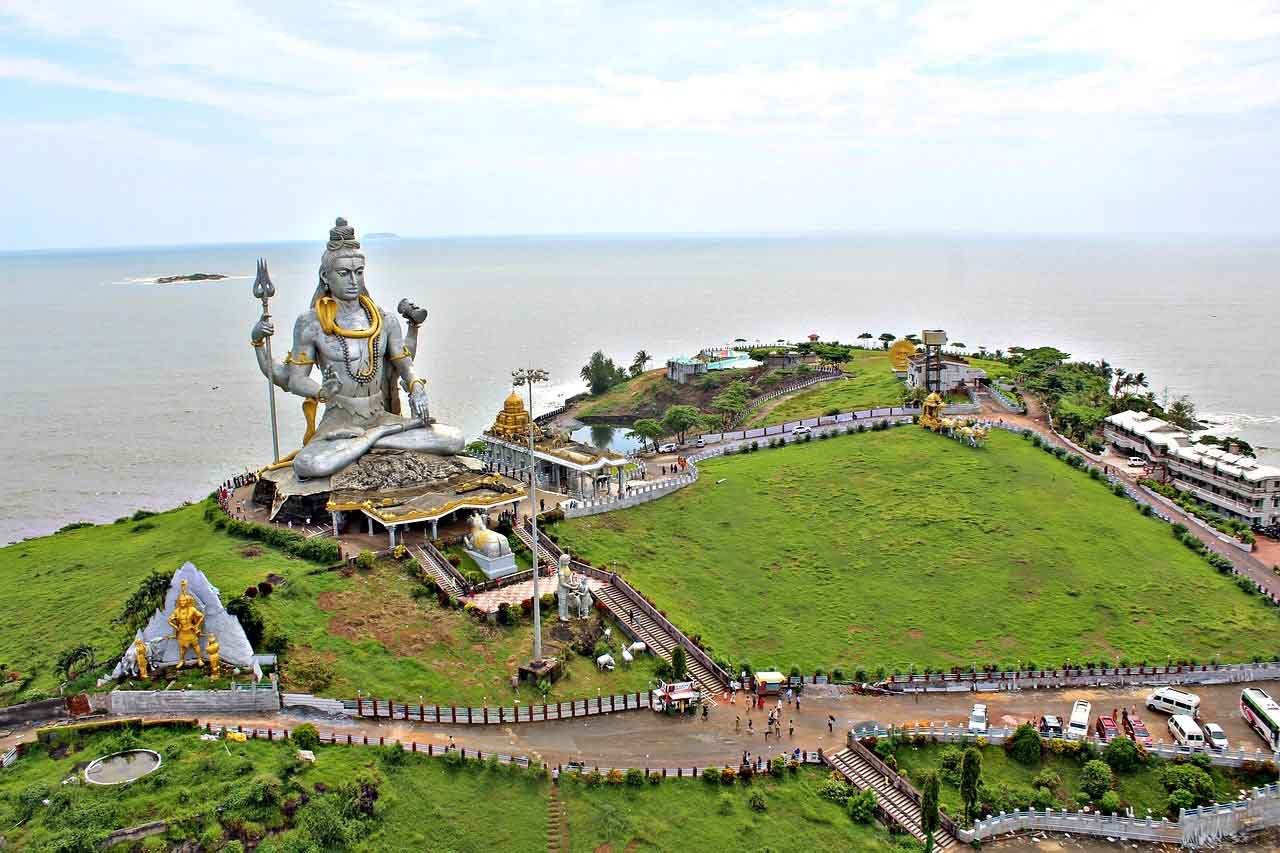
Murudeshwar, a beach town in Karnataka is known mainly for the huge Shiva statue said to be the second tallest in the world. The town also happens to be one of the Shaivite pilgrimages of Karnataka attracting a great number of devotees all through the year.
The main attraction of Murudeshwar Temple is its Rajagopura or the entrance gate. Built in Dravidian style, the gopuram is 249 feet tall. It has 22 floors and you can use the elevator to go to the topmost floor. An elevator ride would cost you Rs.10.00. You will get a beautiful and all-encompassing view of the Arabian Sea, the Shiva statue and the surroundings from the top.
The Shiva statue is 123 feet (37 m) tall and looks spectacular. The Shiva statue along with the Rajagopuram located on the Kanduka Hill is surrounded on three sides by the Arabian Sea. The beauty of the place is unmatched.
Netrani Island near Murudeshwar is an emerging destination for scuba diving.
The nearest airport is at Mangalore. Murudeshwar has a railway station that has train coming from Bangalore and Mangalore.
Telangana Temples
-
Chilkur Balaji Temple

Chilkur Balaji Temple or popularly knowns as “VISA TEMPLE” among locals is located 30 km away from Hyderabad on the banks of Osman Sagar Lake.
This temple was built 500 years ago and is considered as an alternative for the famous Tirumala Temple of Tirupati. Many locals say that this is one of the oldest temples in Telangana. Here we worship Lord Balaji Venkateswara with Indian goddess Sridevi and Bhoodevi.
The unique feature of this temple is that it has no Hundi or Donation box as it depicts no kind of materialism and also preaches us – God’s Love who has given us all things cannot be replaced by any offerings or donations. This is the only temple in India that boasts of not having a donation box or asking for any donations.
The local belief of this temple is to fulfil the wishes of devotees who want to settle or go abroad for their future studies or job. For fulfilling wishes, a devotee has to undergo 11 circumambulations or Parikramas around the inner shrine and when your wish is fulfilled then again go to this temple and have 108 circumambulations or Parikrama around sanctum sanctorum. In Hinduism 11 and 108 are very sacred numbers and they have a great significant meaning.
This temple opens at 5:00 A.M. every morning and till 8:00 P.M. in the evening. Entry is free and generally, weekends and public holidays are very crowded. Nearly 75,000 to 1,00,000 people visit this temple weekly. Mobiles and cameras are not allowed inside and there are lockers at the entrance of the temple where you can deposit them.
Contributed by Yukti Agarwal from Travel With Me 24X7
Kerala Temples
-
Sabarimala Temple

Sabarimala Temple is one of the most famous and prominent pilgrim centres of Kerala. The ancient shrine dedicated to Lord Ayappa is located in the virgin Sabari Hills at an altitude of 914 m inside a dense forest on the Western Ghat mountain ranges. The temple can only be reached by foot from Pamba. The pilgrims have to hike a distance of about 4 km from Pamba.
The pilgrim season is between November and mid-January when thousands of pilgrims make a visit to the Sabarimala Temple. The temple remains closed the rest of the year except for the first five days of every Malayalam month and during Vishu (usually falls in April).
There are no direct train lines near Sabarimala. The nearest railway stations are at Kottayam, Thiruvalla and Chenganur which are about 90 kilometres from Sabarimala.
The nearest main town is Thrissur, if you are coming by road. Thrissur is about 210 km from Sabarimala and you have to take the Moovattupuzha-Kottayam road to reach the temple.
Contributed by Agni & Amrita from Tale of 2 Backpackers
So which of these temples in South India have you visited? If not, plan a trip soon to these beautiful places soon.
Pin this for a later read!
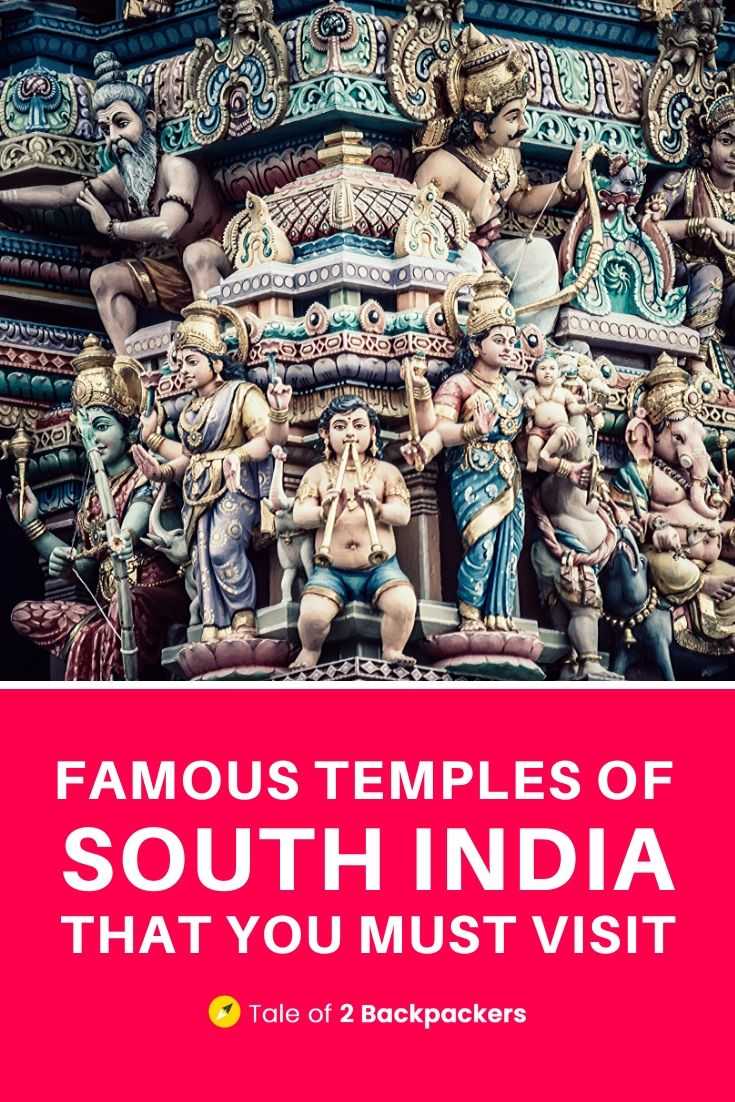
YOU MAY ALSO LIKE:


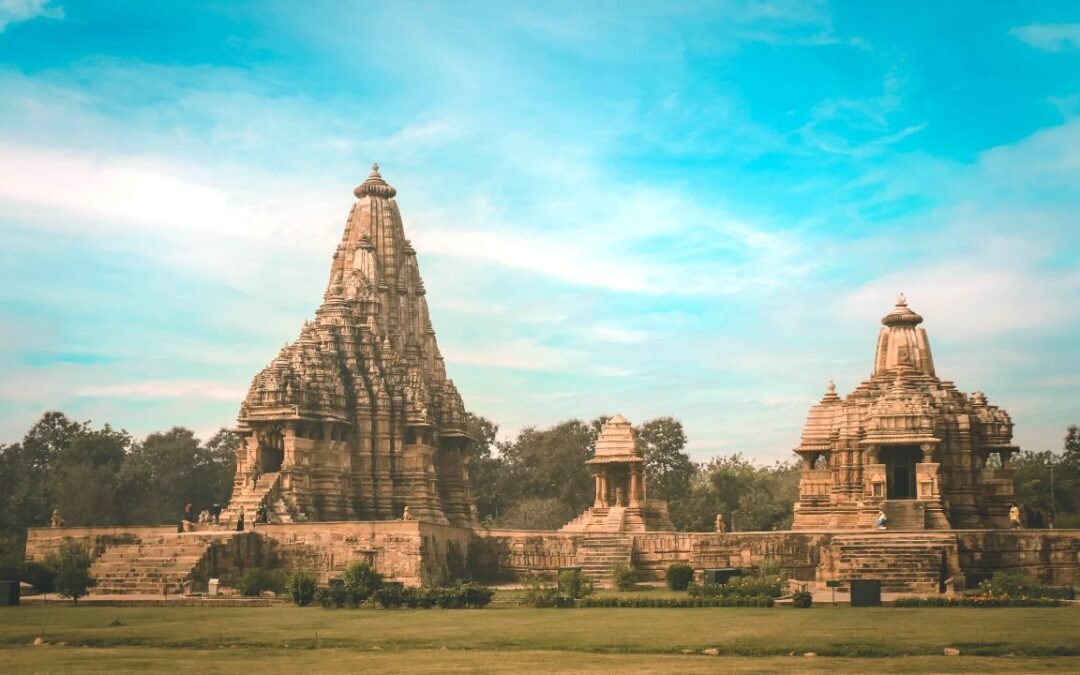




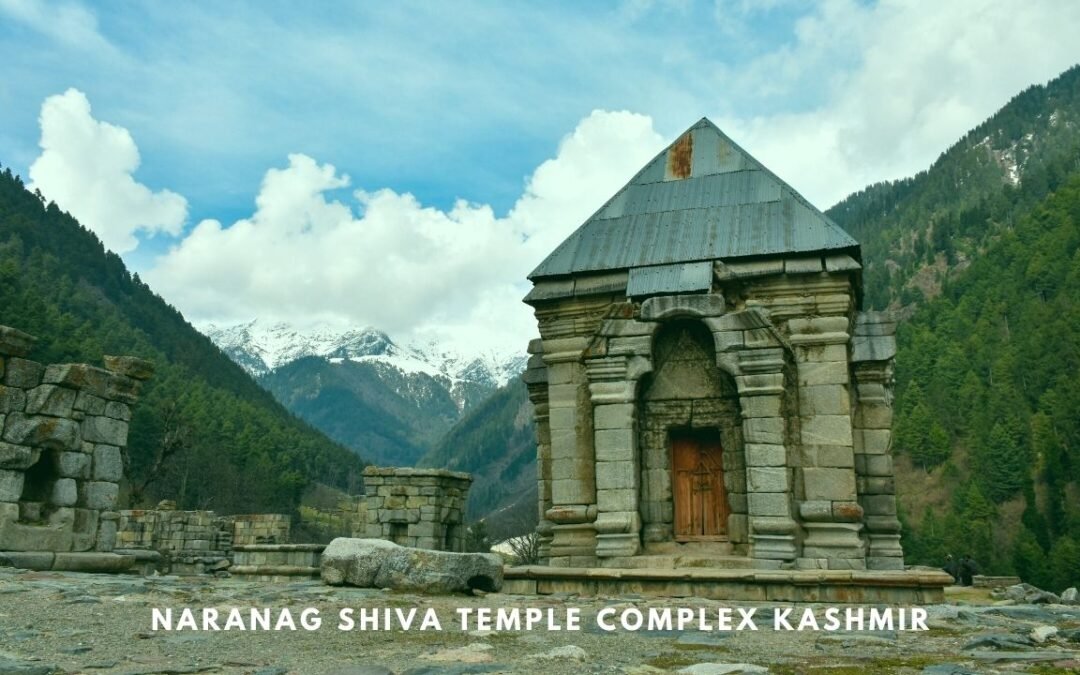

What a lovely topic. The temples of South India are seeped in history and folklore. Loved reading about them.
Thank you Sinjana!
That’s a wonderful idea to mention the best of Indian temples in one articles. I have been to many of these temples and looking forward to visit those where I have not been to. Every stone speaks volumes in these temples. Thanks for featuring my favourite temple.
very truly said Abhinav! The temples do speak volumes. And thank you so much for writing for this post.